Best guitar tuners 2025: my pick of chromatic, polyphonic and strobe options
Stay in tune whatever your budget, with my top picks from Boss, Korg, TC Electronic, D’Addario and more
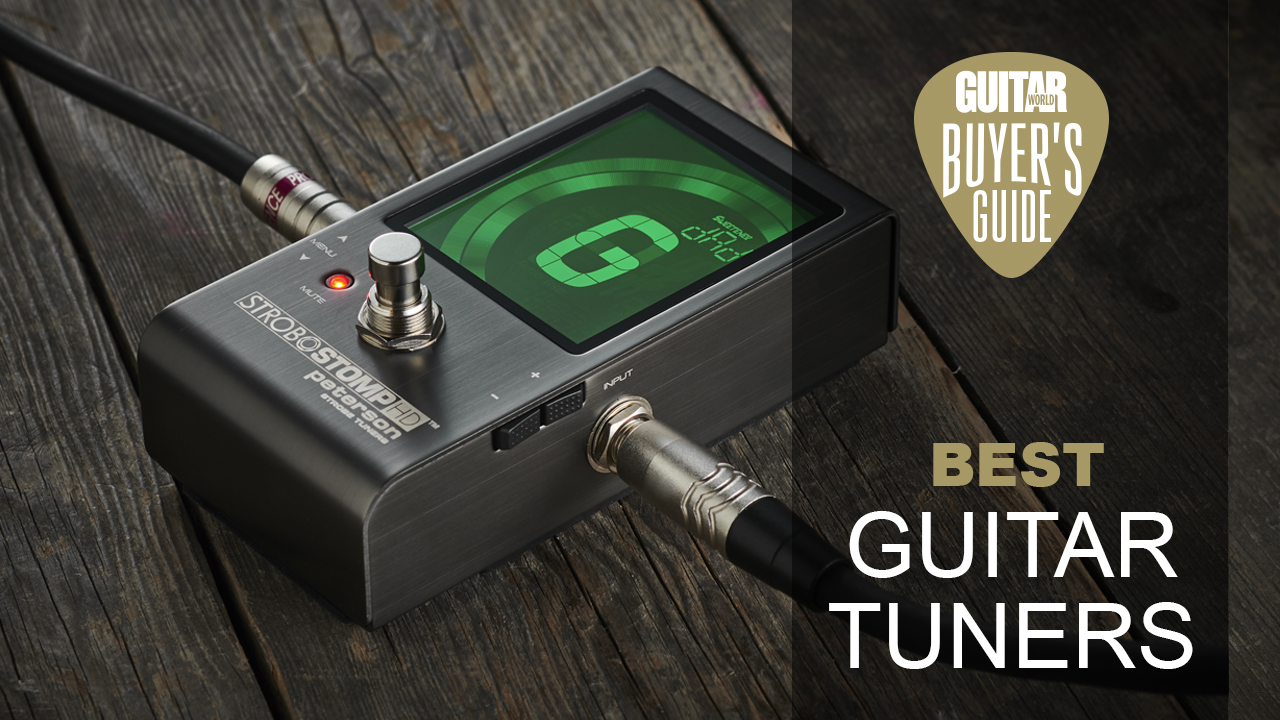
We are guitarists. Some of us are seasoned pros, some are just getting started, and our playing styles, tastes, and gear choices are all over the map. But one thing unites us all: the need to stay in tune. That's where the best guitar tuner comes in.
Whether you're after a road-ready rackmount, a stompbox for your 'board, or a quick and easy clip-on, there is a tuner here for you. Modern options include chromatic, strobe, and polyphonic tuners – sometimes all three in one. What works best depends on your playing context and preferences, and we've done the testing to help you decide.
At Guitar World, we've been gigging, recording, practicing – and yes, tuning – for decades. Personally, after over 20 years of playing, I have seen the good, the bad, and the wildly inaccurate. So in this guide, I've rounded up the very best options available in 2025. But to get you started, my top choice right now is the TC Electronic PolyTune 3 Mini thanks to its compact size, raft of pro-level features and its tuning accuracy.
So, whether you're a bassist struggling with low-end tracking, a tech chasing precise intonation, or a beginner tuning up for the first time, there is something in this guide for you.
For more information, take a look at the FAQ section, and there's also a glossary highlighting all the key terms you need to know when it comes to guitar tuners.
On the hunt for guitar gear savings this Black Friday? Shop our handpicked selection of the best Black Friday guitar deals.
My top picks
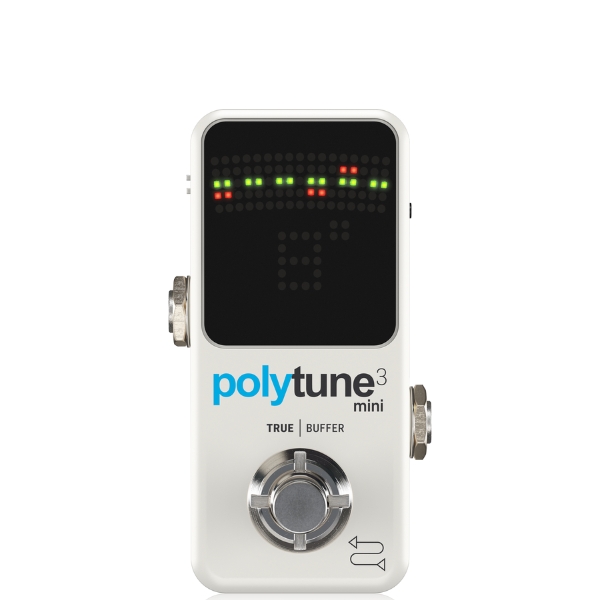
With it's small size, excellent tuning accuracy, and its polyphonic ability to see all your strings' tuning at once, the TC Electronic PolyTune 3 Mini is a brilliant option for any guitar player.

If you're looking for your first tuner then a clip-on is definitely the way to go. The Snark ST-2 Super Tight is absolutely insane value for money, and super accurate too.

Offering pro-level accuracy, three tuning modes, and a crisp, auto-orienting display, this is a top-tier clip-on that doesn't cut corners. Fast, reliable, and perfect for players who want pedal-quality tuning without the pedal.

No list of guitar tuners would be complete without the Boss TU-3. Seen on countless pro guitarists' pedalboards, the rugged build and reliability of the TU-3 make it a great choice.

For bassists, and especially those playing 5-string bass, some tuners won't cut it when you tune that low string. You'll find no such issues with the awesome Korg Pitchblack X however.

The little version of the StroboStomp HD has lots to live up to. Lucky for the little guy, it does everything, including sweetened and guided tunings, always on monitor mode, an accuracy of 0.1 cent and more.
Best overall

Specifications
Reasons to buy
Reasons to avoid
This is perfect for pedalboard-focused players who need fast, reliable tuning in a small footprint. It is ideal for gigging guitarists who value polyphonic tuning and strobe accuracy without sacrificing space or performance.
✅ Buy if you want precise strobe accuracy in a compact format: This mini pedal delivers 0.02 cent accuracy while saving valuable pedalboard space.
❌ Don’t buy if you prefer a larger footswitch: The compact design is ideal for cramped boards, but it may not suit players with bigger feet or boots when playing live.
Build quality: ★★★★½
Features: ★★★★★
Accuracy: ★★★★★
Performance: ★★★★★
Overall: ★★★★★
Compact, clever, and surprisingly capable, the TC Electronic PolyTune 3 Mini proves you don't need a massive pedal to get pro-level performance. Designed for players who want fast, accurate tuning without giving up valuable pedalboard space, this tiny unit brings together multiple tuning modes, road-ready construction, and one of the brightest displays in the business.
Build: Despite its small size, the PolyTune 3 Mini feels seriously tough. Housed in a solid metal enclosure, it's clearly built for gigging life, with a durable footswitch and a weight that inspires confidence. In our review, we found that the mini format does come with trade-offs, most notably the tight switching space, which might frustrate players with larger feet or complex board setups.
Features: For such a tiny box, there's a lot going on. The three tuning modes – polyphonic, chromatic, and strobe – cover everything from quick on-stage tune-ups to precise bench setups. The polyphonic mode lets you check all six strings with a single strum, while the strobe mode delivers hair-splitting accuracy. Add in the option to toggle between true bypass and buffered output, and you have a tuner that leaves little to complain about.
Accuracy: This is where the PolyTune really pulls ahead of the pack. In strobe mode, it offers 0.02 cent accuracy, making it ideal for players who need flawless intonation for the studio or do regular setup work. Even outside strobe mode, it tracks quickly and reliably, with little to no lag or jitter.
Performance: The 109-LED matrix display is a standout feature, offering crystal-clear visuals whether you're on a dark stage or under blinding sunlight. I found the always-on tuning mode especially useful during rehearsals and gigs, allowing for on-the-fly checks without engaging the footswitch. In day-to-day use, it's a responsive and consistent performer – quiet, accurate, and always ready to go.

"The TC Electronic PolyTune Mini 3 is a shrunken version of TC’s best tuner pedal yet. It’s easy to use, durable and highly accurate - all you could ask for from a tuner."
Read more: TC Electronic PolyTune 3 Mini review
Best for beginners
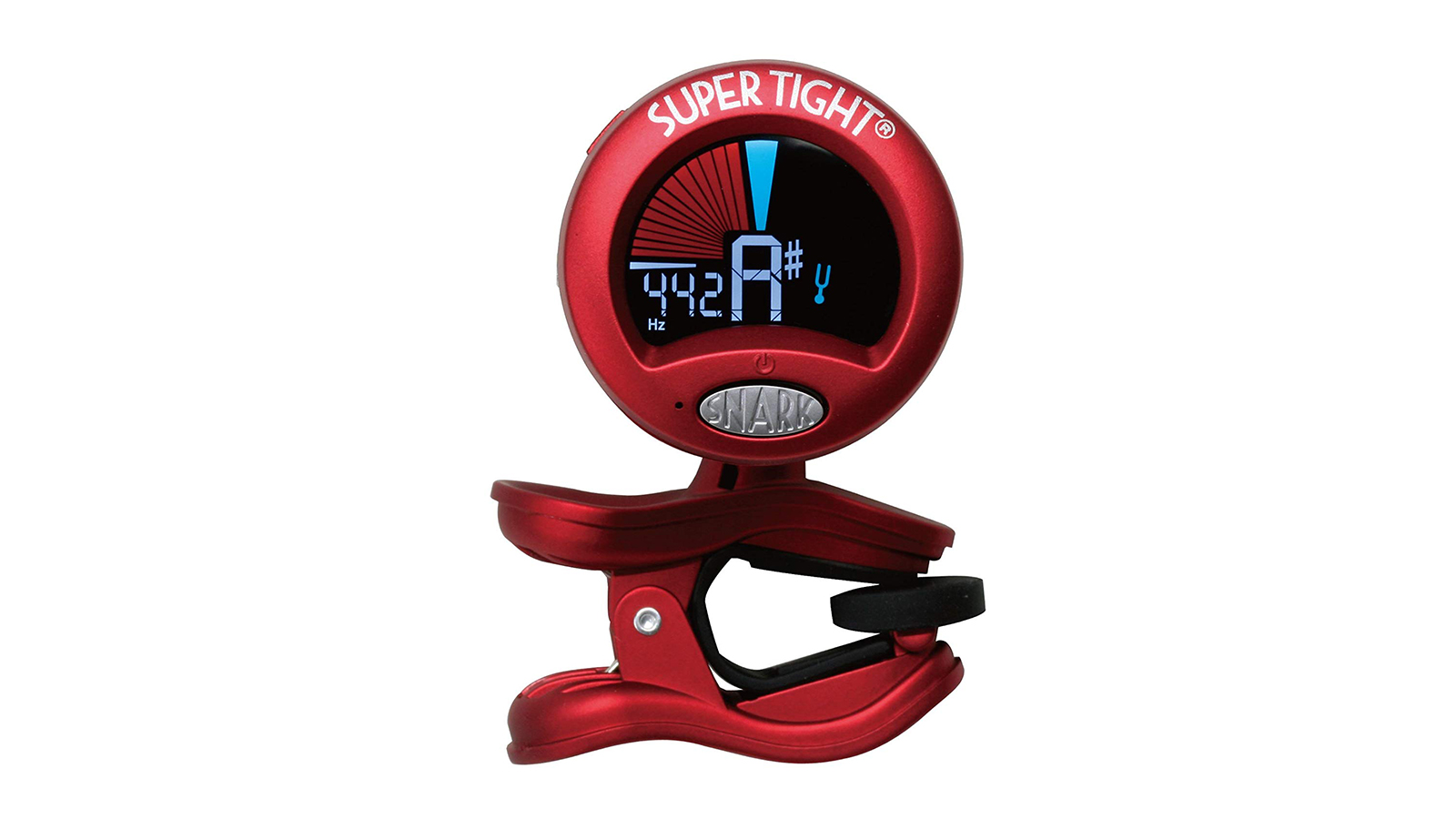
2. Snark ST-2 Super Tight Guitar Tuner
Our expert review:
Specifications
Reasons to buy
Reasons to avoid
If you're just beginning or need a no-nonsense, straightforward clip-on tuner, go for the Snark ST-2. It's easy to use, has a generously sized display, and will cover both guitar and bass. Although the tuning range isn’t specified, the ST-2 covers the basics well.
✅ Buy if you need something quick, reliable & affordable: Sometimes we guitarists don’t want to reach for our pedalboard to tune. If you fall in that camp, the ST-2 is an affordable option to keep at hand.
❌ Don’t buy if you rely on pinpoint accuracy: Although Snark hasn’t revealed the accuracy stats, the ST-2 isn’t the most accurate. Opt for another if you’re in the studio about to record a track.
Build quality: ★★★★
Features: ★★★★
Accuracy: ★★★
Performance: ★★★★
Overall: ★★★★
There's a reason the Snark ST-2 has stuck around: it's cheap, cheerful, and does exactly what you need it to. At this price, it's worth grabbing one even if it just lives in your gig bag or guitar case as a backup. It might not be packed with pro-level features, but that’s the point. The ST-2 is made for players who just want something simple, quick, and reliable.
Build: For such a budget-friendly tuner, the ST-2 feels more solid than you'd expect. The clamp is sturdy and holds well on everything from headstocks to music stands. The ball joint makes it easy to get a clear view of the screen, which is crucial when you’re dealing with tight tuner spacing on 12-strings, mandolins, or bass guitars.
Features: This is not a feature-packed unit, but it does have a built-in tap tempo metronome for practicing new songs. It covers the basics well and you’ve got a built-in mic for acoustic instruments, plus a vibration sensor mode that works great in most situations, just don’t expect miracles in loud rehearsal spaces. It's not loaded with strobe or polyphonic modes, but for casual tuning, it gets the job done.
Accuracy: While it's not the most precise tuner on the list, the ST-2 is consistent enough for everyday use. The tracking is surprisingly quick, and for the price, it performs better than expected. As long as you're not setting intonation or recording a string quartet, it's more than serviceable.
Performance: Pop it on, tune up, and you are good to go. The screen is clear and vibrant, the response is fast, and the whole experience is pretty much hassle-free. It's a great grab-and-go option for beginners, home players, or anyone looking for a reliable spare.
Best clip-on
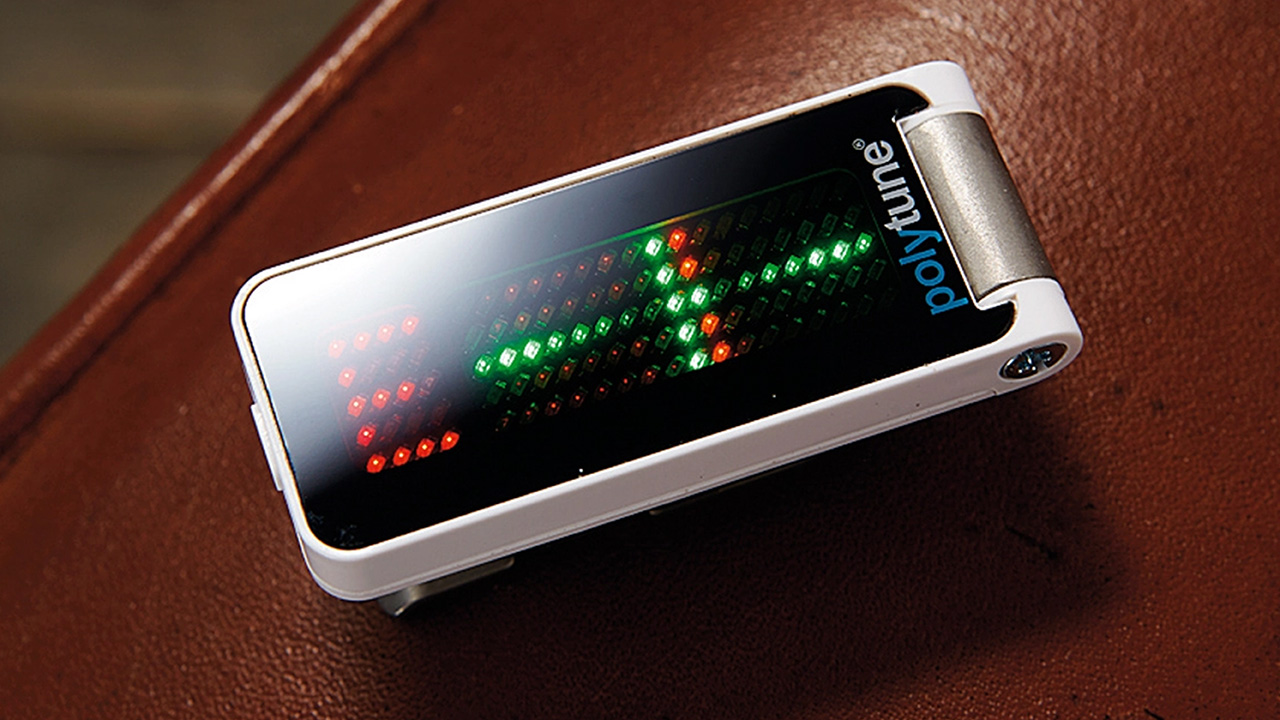
3. TC Electronic Polytune Clip
Our expert review:
Specifications
Reasons to buy
Reasons to avoid
If you are after the ease, speed, and hassle-free convenience of a clip-on tuner but don’t want to sacrifice accuracy, the PolyTune Clip is the one for you. Its bright display and versatile tuning modes easily put it among the best.
✅ Buy if you want the convenience of a clip-on: Being able to carry this accurate little tuner in your pocket, not having to rely on mains supply, yet still benefiting from supreme accuracy, is fantastic.
❌ Don’t buy if you have a nitrocellulose finish guitar: Unfortunately, the rubber grips on this tuner can react with sensitive nitro finishes, causing damage.
Build quality: ★★★★
Features: ★★★★★
Accuracy: ★★★★★
Performance: ★★★★½
Overall: ★★★★½
Clip-on guitar tuners used to be seen as the poor cousins of pedal-based options, fine in a pinch, but rarely professional. However, the TC Electronic PolyTune Clip helped rewrite that narrative. Offering three tuning modes, 0.02 cent strobe-level accuracy, and a super-bright 108-LED display, it's one of the few clip-ons that truly holds its own against full-size pedal tuners.
Build: The PolyTune Clip looks sleek and feels solid in hand. The rubber-lined clamp grips most headstocks securely, though one downside is that it's not safe to leave on guitars with nitrocellulose finishes. As with any battery-powered clip-on, you'll want to keep spare batteries handy if you're gigging regularly. But overall, it's compact, discreet, and clearly built to a high spec.
Features: You get a surprising amount of functionality for such a small unit. Alongside the usual chromatic mode, there's polyphonic tuning – ideal for quick checks across all six strings – and an ultra-accurate strobe mode for setups or players who like to be really in tune. This is more accurate than most pedal units in my list.
The super-bright 108-LED display auto-rotates depending on orientation, and the layout is sharp, clear, and visible even on bright outdoor stages. On top of that, there's ‘capo’ and ‘flat’ reference pitch selection that accounts for the quirks of tuning with a capo and allows you to adjust for drop tunings.
Accuracy: For a clip-on tuner, the Polytune Clip is exceptional. The strobe mode is rated to 0.02 cents, putting it among the most accurate clip-on tuners available. Chromatic mode is still impressively stable and responsive at 0.05 cents. Whether you are tuning for a lesson, going to a jam, or even in the studio, the Polytune Clip holds its own.
Performance: In day-to-day use, the PolyTune Clip is fast, fuss-free, and genuinely pleasant to use. The large auto-rotating LED display makes a real difference when it counts and will self-adjust depending on whether you're right or left-handed. Also, if you're moving between guitars, it clips on and off with ease, and it's small enough to live in your case, pocket, or gig bag without a second thought.
Best durability

4. Boss TU-3 Chromatic Tuner
Our expert review:
Specifications
Reasons to buy
Reasons to avoid
Since its inception, the Boss TU-3 has been a go-to for players who demand durability, precision and no faffs. The current iteration is no exception, offering a rugged chassis, a large footswitch, and 1-cent accuracy in both strobe and chromatic modes.
✅ Buy if you need your pedals to last a beating: The TU-3 is the most durable on our list and can withstand even the most heavy-footed.
❌ Don’t buy if you can’t live with buffered bypass: The TU-3 doesn’t offer true bypass, which might be a dealbreaker for tone purists.
Build quality: ★★★★★
Features: ★★★★½
Accuracy: ★★★★½
Performance: ★★★★★
Overall: ★★★★½
Launched as the successor to the now-iconic TU-2, the Boss TU-3 has cemented itself as the industry standard for stompbox tuners. Found on the 'boards of touring pros and bedroom players alike, this thing is less of a pedal and more of a rite of passage. If you've ever stepped on one, you know: it's not going anywhere, literally or figuratively.
Build: Built like a tank? No, it is a tank. The TU-3 is one of the most rugged pedals on the market, with a chunky metal chassis, a rock-solid footswitch, and the kind of road-ready construction that shrugs off knocks, drops, and beer spills without flinching. The large stomp area is easy to hit mid-gig, even in the dark, and the whole unit feels engineered to outlive your current band and the next one.
Features: The TU-3 is not flashy, but it nails the fundamentals. It features a bright 21-segment LED meter for easy tuning in all lighting conditions, with a selectable high-brightness mode for outdoor stages. You get both chromatic and strobe tuning modes, a flat tuning option for drop tunings, and a tuning range that covers everything from bass to guitar and beyond. The onboard output mute function makes silent tuning seamless, and there’s even a DC out to power other pedals.
Accuracy: With 1-cent accuracy in both chromatic and strobe modes, the TU-3 might not be the most precise tuner on the list, but it's more than enough for most real-world playing scenarios. Whether you're tuning up before a set or doing quick checks between songs, it locks on fast and doesn’t waver, exactly what you want when time and tone matter.
Performance: This is where the TU-3 really shows its pedigree. It's simple to use, reliable in any situation, and immune to stage chaos. The display is easy to read, the switching is instant, and there’s no messing around with menus or modes. The only real knock is that it only offers buffered bypass, great for preserving signal over long cable runs, but not ideal for players who insist on true bypass. Still, if you want a tuner that’ll never let you down, this is the one.
Best for bass

Specifications
Reasons to buy
Reasons to avoid
The Pitchblack X suits players of all styles thanks to its bright LED screen, four tuning modes, and tough aluminium build. That said, bassists should pay close attention; in our review, it tracked low-end notes with impressive accuracy.
✅ Buy if you are looking for a pedal tuner for bass: We found its low-end tracking is superb, making it a great fit for bassists needing precision on the bottom end.
❌ Don’t buy if you are a fan of polyphonic tuning: Although there are many positives, the Pitchblack X isn’t loaded with polyphonic tuning.
Build quality: ★★★★★
Features: ★★★★★★
Accuracy: ★★★★½
Performance: ★★★★★
Overall: ★★★★★
Korg knows a thing or two about music tech. From synthesizers to drum machines and yes, tuners. They've built a reputation for forward-thinking, technically proficient gear. So it's no surprise that the Pitchblack X stands out as one of the best pedal tuners on the market. It's a standard-size stompbox that fits easily on most pedalboards and, notably, it is a particularly strong choice for bass guitar players. In our review, we found it handled low-end tracking with ease.
Build: One of the most appealing aspects of the Pitchblack X is its rugged construction. The aluminium chassis gives it a reassuring weight, and the scratch-resistant finish means it’ll stay looking sharp even after years of stage use. It's clearly built to take a beating. While the side-mounted audio jacks might frustrate players with dense 'board layouts, the top-mounted power input is a thoughtful touch that keeps things clean and practical.
Features: Feature-wise, the Pitchblack X is one of the most stacked tuners in this guide. It offers four tuning modes – Regular, Strobe, Half-Strobe, and the unique Mirror mode. Mirror is a standout: using converging LED strips from either side of the screen, it gives you a visual target to hit as you tune. It takes a moment to adjust to, but it's clever and effective once you get the hang of it. The unit runs on a 9V power supply or battery, making it flexible enough for home, studio, or travel use.
Accuracy: Accuracy is where a pedal tuner proves its worth, and the Pitchblack X doesn't disappoint. With up to 0.1 cent precision, it's more than capable for studio sessions, rehearsals, or live shows. Whether you're syncing up with synths or chasing intonation perfection, this pedal is reliable and stable.
Performance: Lastly, the Pitchblack X is a breeze to use. The LED display is incredibly bright and easy to read, with two brightness levels to suit different stage conditions. Against the black housing, it stands out clearly from the floor, no squinting required. Also worth noting is the inclusion of Korg’s “ultra-buffer” mode, which helps preserve your tone over long cable runs or complex setups. It's a thoughtful addition that reinforces this pedal’s all-around usefulness.

"Boasting four display options, a big and easy to read screen, two brightness settings, +/- 0.1 cent accuracy range and a buffered/true bypass switch, the Korg Pitchblack X has it all."
Read more: Korg Pitchblack X review
Best for intonation
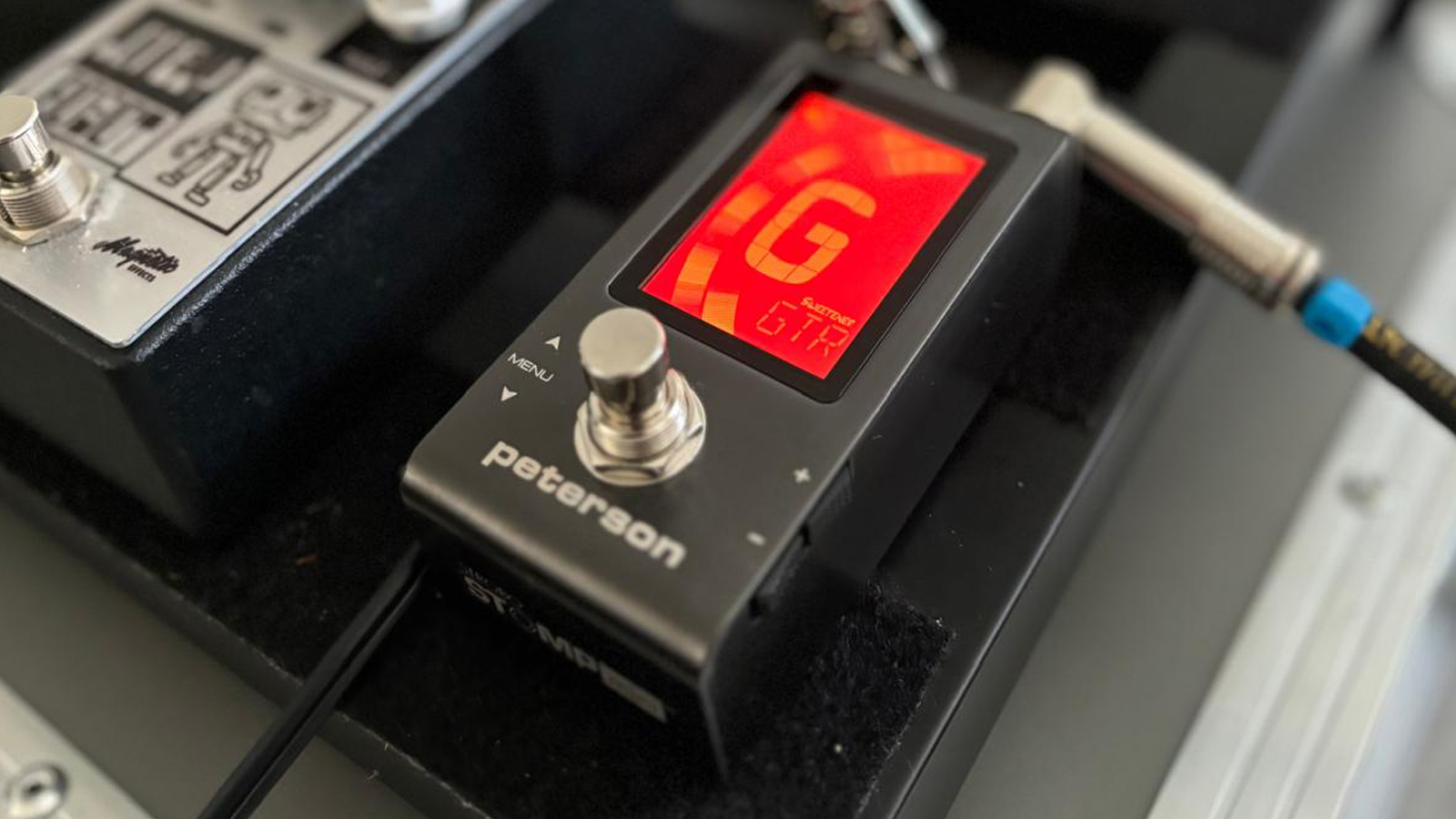
Specifications
Reasons to buy
Reasons to avoid
The Peterson name carries serious weight, and the StroboStomp Mini delivers that prestige in a compact, well-built tuner loaded with features like sweetened tunings, guided modes, and switchable bypass options, all with 0.1-cent accuracy. Ideal for players who need a space-saving, feature-packed pedal that doesn’t compromise on precision.
✅ Buy if you have a big collection of guitars: The sweetened tunings feature is fantastic for nailing tuning from Telecasters to Les Pauls and accounting for their quirks.
❌ Don’t buy if you’re after something basic: Although this is feature-packed, it won’t appeal to those who only need their tuner to do one thing: tune.
Build quality: ★★★★½
Features: ★★★★★
Accuracy: ★★★★
Performance: ★★★
Overall: ★★★★
Peterson is a company that mainly focuses on tuners. Sure, they do the odd accessory, but guitar tuners are their bread and butter. The much-loved StroboStomp HD is a perennial favorite among musicians worldwide, but what's better than that? The StroboStomp Mini. It's essentially the same pedal, packed with all the coveted features, just in a smaller, pedalboard-friendly chassis.
Build quality: I found the metal chassis had a premium feel, and even the included cut-to-size Velcro and tidy packaging reflect Peterson’s attention to detail. The footswitch is sturdy yet silent, a small but welcome touch that makes the Mini feel refined from the moment you plug it in. There's little to fault in the build here, and for a company that hangs its hat on tuning precision, I wouldn’t expect anything less.
Features: The Mini is loaded with Peterson’s signature tuning tools, including sweetened and guided tunings, which are fantastic if you’ve got a varied guitar collection. Sweetened tunings take into account the quirks of different setups, like the tuning idiosyncrasies between a top-loaded Tele and a Floyd Rose-equipped Ibanez. Presets cover everything from 12-string guitars to acoustics, electrics, and even flattened B-string EVH-style tunings.
The pedal also offers both a pop-less true bypass mode and a buffered output, letting you tailor it to your rig without sacrificing tone. Add in a USB-C port for firmware updates and a compact, pedalboard-friendly footprint, and it’s clear this little unit was made with working musicians in mind.
Accuracy: The StroboStomp Mini is rock solid. With tuning precision down to 0.1 cents, it's more than capable for studio, live, or tech work. Strobe mode, in particular, is highly sensitive. Some players may find it takes a little getting used to if they’ve never used a strobe tuner before, but the payoff in precision is absolutely worth it.
Performance: On the floor, the StroboStomp Mini is a quiet and confident performer. The multi-color backlit LCD is crisp and clear in all lighting conditions, and its compact footprint makes it an easy addition to any 'board, especially if space is tight. The pedal is completely silent when switched, and the inclusion of true and buffered bypass modes, plus a USB-C port for firmware updates, adds versatility for modern setups.

"While not all of the features within this pedal are necessary for everyone, the StroboStomp Mini is an incredibly accurate and reliable tuner. It’s compact, and it’s built to an excellent standard, so it will last for years to come."
Read more: Peterson StroboStomp Mini review
Best hybrid
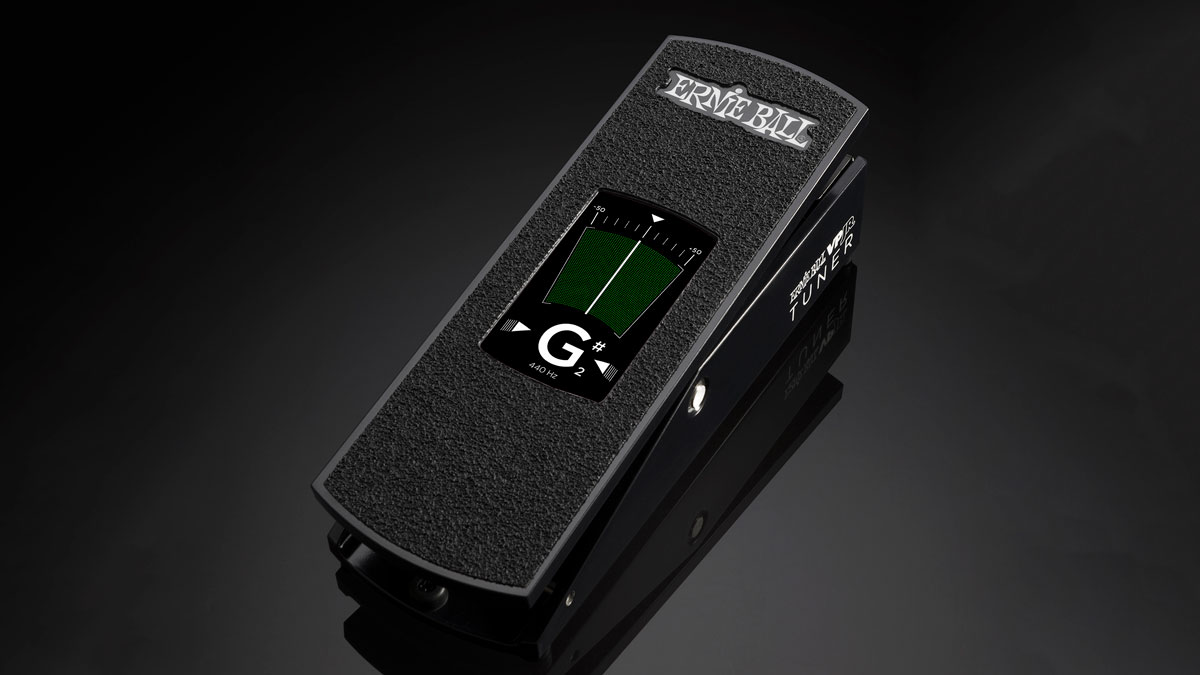
Specifications
Reasons to buy
Reasons to avoid
The VPJR Tuner is perfect for players who already rely on a volume pedal and tuner, but want to free up pedalboard space by combining both into one smart, stage-ready unit.
✅ Buy if you want to blend utility with quality: Made from aircraft-grade aluminum, the VPJR is built like a tank, features a brilliant display, and can multitask better than most guitarists.
❌ Don’t buy if you like using tuning modes other than chromatic: Although the VPJR can do two things at once, the tuner doesn’t offer strobe, mirror, or any other types.
Build quality: ★★★★★
Features: ★★★★½
Accuracy: ★★★★½
Performance: ★★★★★
Overall: ★★★★★
Ernie Ball is arguably the biggest accessory brand in the guitar world. Those bright, fluorescent string packs are a staple in guitar shops across the globe. But beyond strings, Ernie Ball has been crafting volume pedals since 1977. Why does that matter here? Because the VPJR takes that decades-old volume pedal design and blends it with a precise onboard tuner, creating one of the most practical hybrid pedals on the market.
Build: Out of the box, the VPJR feels like it could survive a nuclear event. Made from aircraft-grade aluminum, it is solid, heavy, and clearly built to last. Premium features include a high-quality buffer circuit, FX send/return jacks, a non-slip grip surface, and a PVC-coated braided Kevlar cord to keep tension smooth and consistent as you sweep the pedal. In terms of sheer durability, there aren’t many pedals that feel more road-ready than this.
Features: The VPJR seamlessly combines a volume pedal with a digital chromatic tuner that can operate in three distinct modes. In the default ‘volume + tuning’ mode, the tuner is active when the pedal is in heel-down position, and a volume readout appears as you increase the signal. You can also choose ‘tuner only’ or ‘volume only’ modes if you prefer to keep things simple.
Beyond that, the VPJR can be calibrated across a wide range of reference pitches, works as either a master volume or gain control, and handles both passive and active signals with ease. The only downside is its lack of alternate tuning modes; it's chromatic-only, which might be limiting for some.
Accuracy: Tuning accuracy is rated at 0.1 cent, which puts it right up there with the most precise pedals on this list. In practice, it tracks quickly and consistently, with no lag or jitter. Whether you're making quick adjustments between songs or doing more deliberate tuning on a studio session, it handles pitch detection with confidence. The chromatic-only limitation won’t matter for most players, and what it does, it does very well, especially for live use.
Performance: In use, the VPJR is a real joy. The LCD touchscreen on the treadle offers responsive needle-style tuning feedback that feels immediate and reliable. The display glows blue when you’re sharp or flat, and shifts to green when your pitch is spot-on, simple, intuitive, and easy to see even on a dark stage.

The Ernie Ball VPJR guitar tuner is a clever, space-saving pedalboard idea that's been brilliantly executed."
Read more: Ernie Ball VPJR Tuner review
Best rack mount
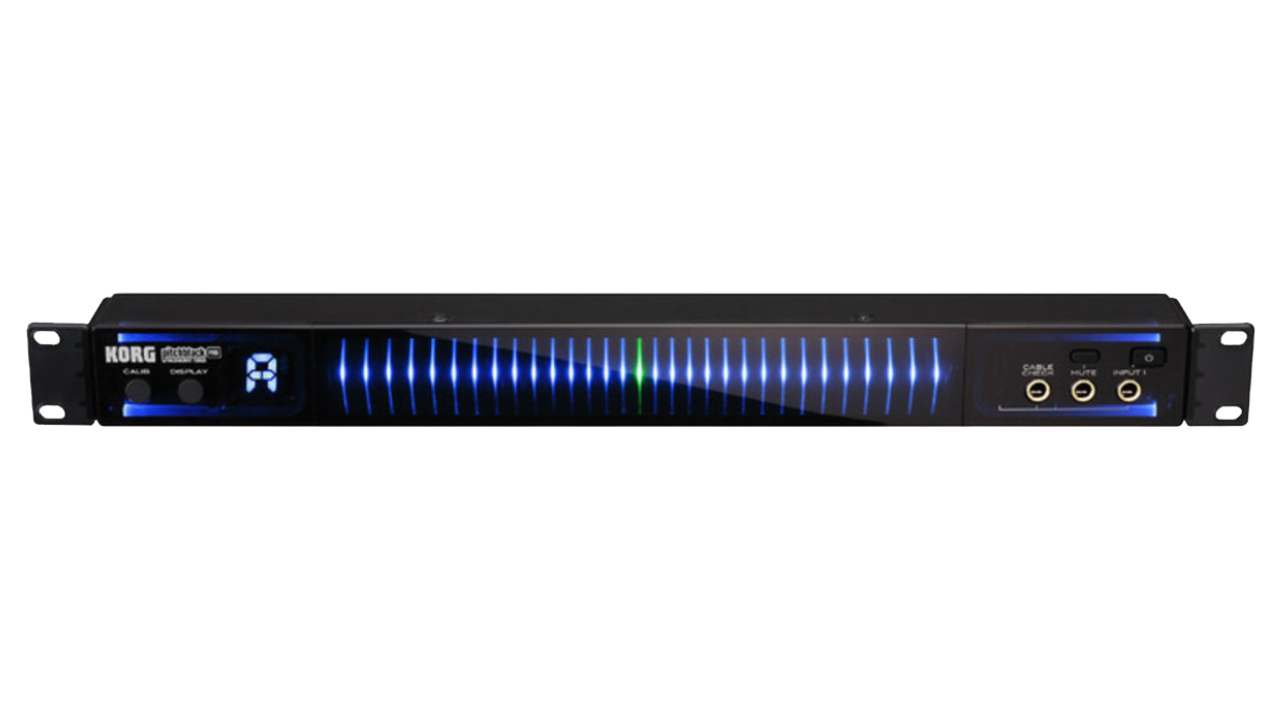
8. Korg Pitchblack X Pro rackmount tuner
Our expert review:
Specifications
Reasons to buy
Reasons to avoid
The Pitchblack X Pro rack mount is the go-to choice for studio wizards, practice room spaces or anyone with a touring rack. With an ultra buffer, a built-in cable checker and a fully customizable LED color scheme, this isn’t for the faint of heart. It's high-tech studio gear for those looking for the best.
✅ Buy if you need a touring-grade tuner: The Korg Pitchblack X Pro is designed for professional-level guitarists who need a robust rackmount solution.
❌ Don’t buy if you're playing smaller venues: Unless you're playing large shows, we'd go with a pedalboard-mounted tuner versus a rack-mounted one.
Build quality: ★★★★½
Features: ★★★★★
Accuracy: ★★★★½
Performance: ★★★★★
Overall: ★★★★½
Rackmount tuners aren't for everyone, but if you're working with a studio rack or want maximum visibility and precision, the Pitchblack X Pro makes a seriously strong case. It takes everything that's great about the Pitchblack X pedal and gives it the real estate to shine. With a huge screen, tight accuracy, and smart functionality, it's designed for guitarists and bassists who need no-compromise performance from their rack gear.
Build: The Pitchblack X Pro is certainly pro-grade studio equipment. It's cleanly finished and slides easily into any existing rack setup. If you've already got outboard gear mounted up, adding this is a no-brainer. The unit feels pretty solid and won’t be going anywhere once it's bolted in. However, it would be a welcome upgrade if Korg supplied an aluminum chassis with the rack mount.
Features: You get all the expected highlights of a Pitchblack series tuner like true bypass, Ultra Buffer, and four meter display modes, plus some fantastic additions that justify the expanded format. A built-in cable checker is handy for fast troubleshooting, and the fully customizable LED color scheme lets you tailor the display to your preference or to match your stage outfit. You can also choose from five presets, including full-spectrum gradients or solid colors for visibility that suits you best.
Accuracy: Tuning is fast and incredibly precise, with 0.1 cent accuracy. That level of detail is ideal for intonation tweaks, studio tracking, or just making sure your instrument is perfectly dialed in before hitting record. The oversized screen makes subtle adjustments easy to read, even across a noisy, dimly lit rehearsal space.
Performance: This is a tuner built for practical, everyday use in demanding environments. The screen is the standout here: large, bright, and highly responsive. Whether you're standing at a rack across the room or working at eye level, you'll never struggle to see what is going on.
Best for acoustic
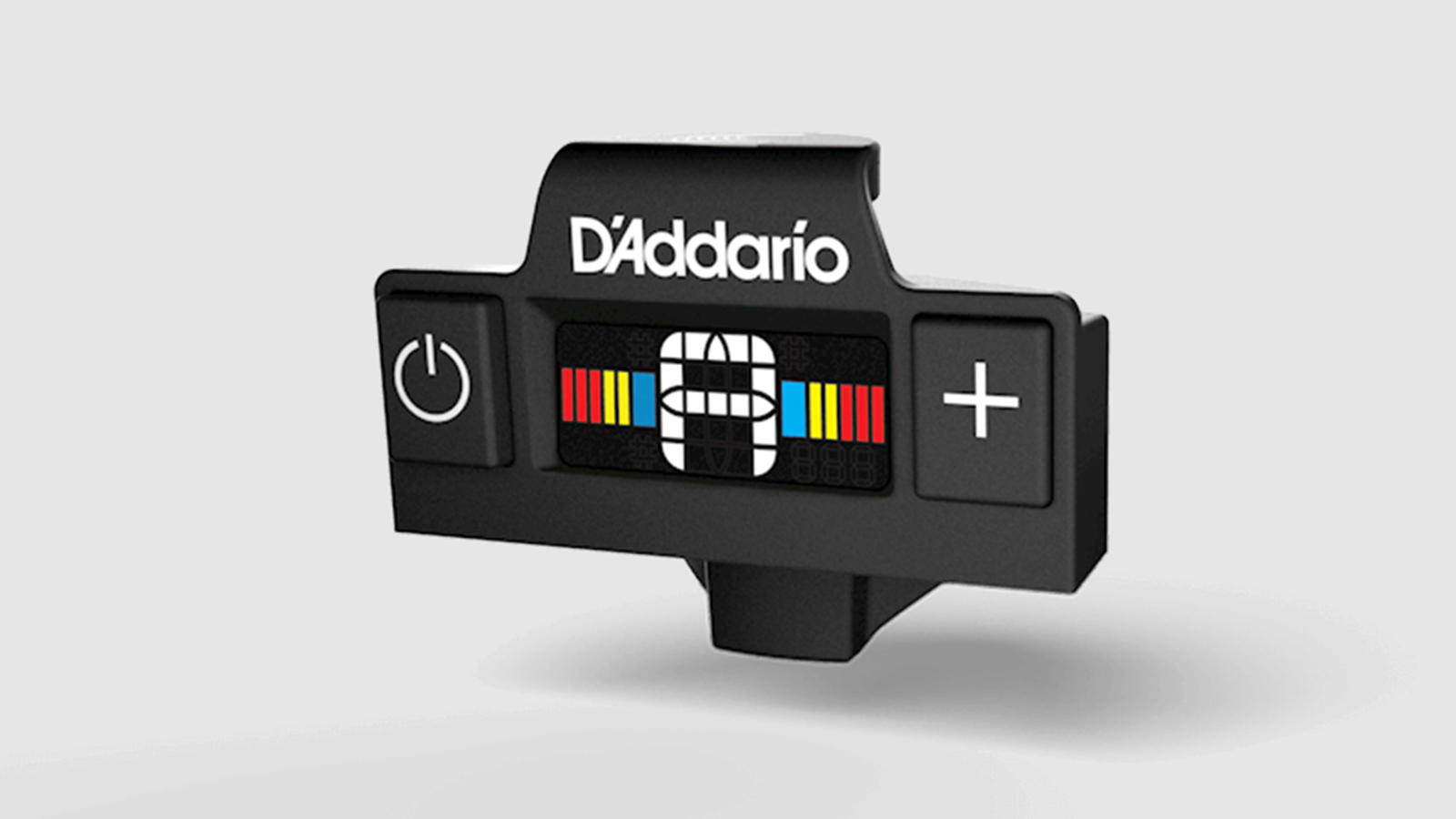
9. D’Addario NS Micro Soundhole Guitar Tuner
Our expert review:
Specifications
Reasons to buy
Reasons to avoid
The NS Micro Soundhole is a bit of a stealth operator. Nestled out of sight inside your acoustic sound hole, it’s ideal for players who like to set and forget and perfect for those who think clip-on tuners ruin the look of a good headstock.
✅ Buy if you need a discreet acoustic guitar tuner: Able to clip to your soundhole, this tuner is perfect for guitarists who don't want to ruin the looks of their instrument.
❌ Don’t buy if you don't play acoustic: This won't work on non-acoustic instruments, so not one for the electric guitar players out there.
Build quality: ★★★★
Features: ★★★★
Accuracy: ★★★★
Performance: ★★★★
Overall: ★★★★
Acoustic players don’t always want a tuner hanging off the headstock or taking up space on a pedalboard. Enter the D’Addario NS Micro Soundhole Tuner, a clever little device that tucks away inside your guitar’s soundhole, keeping your setup clean and your tuning on point.
Build: Despite its small size, the NS Micro is solid and designed specifically for acoustic instruments. It clips into your soundhole using a non-marking, tension-based mount that won’t damage your finish. Once in place, it stays put without getting in the way, even during more energetic playing. The whole thing is lightweight and discreet, making it a natural fit for minimalists and traditionalists alike.
Features: This is a vibration-based tuner that reads directly from your instrument’s top, bypassing the need for a microphone. That means it is less likely to be thrown off by background noise, making it workable for rehearsals, sessions, or tuning up side-stage. The bright multi-color screen is surprisingly readable given its size, and the single-button interface keeps things nice and simple. There isn’t a strobe or polyphonic mode available here, but D’Addario has prioritized subtlety and ease of use instead.
Accuracy: The NS Micro may not offer ultra-fine tuning down to tenths of a cent, but it is consistent, reliable, and accurate enough for acoustic sessions and live gigs at 0.3 cents. It responds quickly to input, locks on with minimal fuss and works well with standard tuning needs.
Performance: Once it is in, you can forget about it, and that’s really the appeal. The display is clear and responsive, the tuner itself is unobtrusive, and it gets the job done without needing power cables, extra space, or attention. For acoustic players looking for a “fit and forget” solution, this is a seriously handy bit of kit.
How to choose a guitar tuner
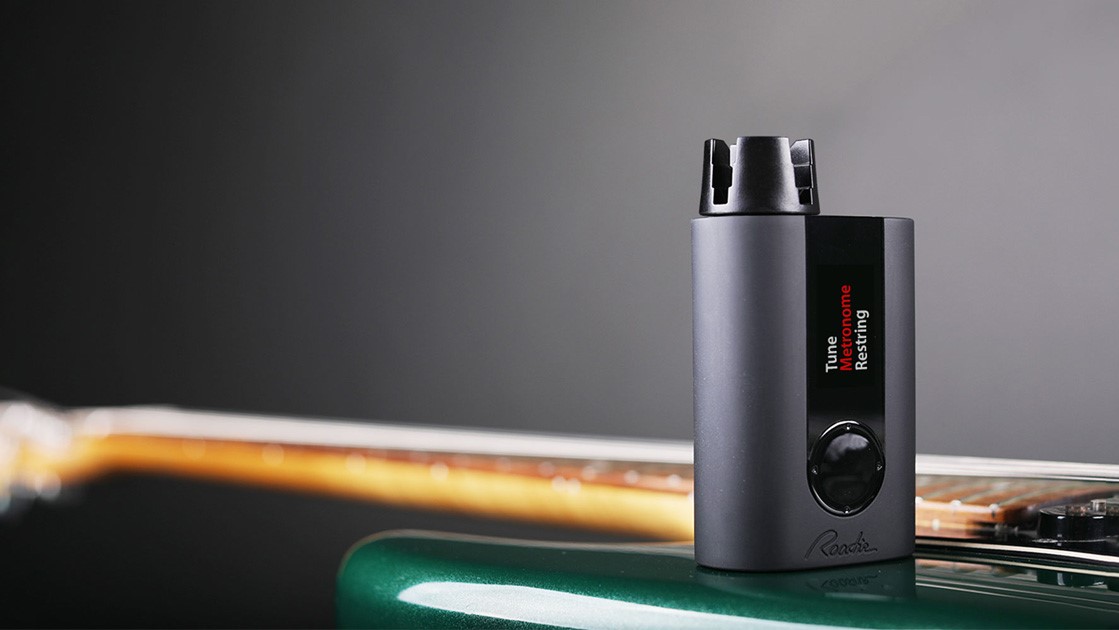
Although buying a guitar tuner is not the most glamorous purchase in your guitar-playing career, it is certainly one of the most important. Whether you are a beginner or a seasoned veteran, being in tune is non-negotiable and the best tuner will make your life a whole lot easier. Plus, it will get your flatmates, band or producer off your back. So, what should you be looking for?
Start by thinking about how and when you play. Are you mostly jamming at home? Gigging every weekend? Recording in a studio? The answer will help you choose between the three main types of tuners: clip-on, pedal, and rackmount.
1. Type
Clip-on tuners are ideal if you want something simple and portable. They attach to your guitar’s headstock and read vibrations, meaning they can work well in most noisy environments and without the need for any cables. They are a solid option for beginners, acoustic players, or anyone who just wants to grab, tune, and go.
Pedal tuners, on the other hand, are the go-to for most gigging electric guitarists. They sit on your pedalboard and take your guitar signal directly, so they are fast and extremely accurate. Many offer extra features like mute switching, buffering, or multiple display modes. If you are building a board or already have one, a good pedal tuner is a must-have.
Rackmount tuners are less common but incredibly precise. These are typically found in studio setups, on pro touring rigs or in practice rooms. Their big advantage is the huge display, which makes fine-tuning fast and easy, especially from across a room. But unless you have already got a rack system, they are likely overkill and impractical.
2. Modes
Once you have nailed down the format, it is time to think about how your tuner actually reads pitch. Most tuners today are either chromatic, strobe or polyphonic. Chromatic tuners are the most common; they detect all 12 notes in the scale and tell you where you are in relation to pitch. They are easy to read and work for any tuning you throw at them.
Strobe tuners work slightly differently. They show tuning accuracy by how a graphic display moves or 'strobes' in response to the note being played. When the movement stops, you are in tune. These are typically much more precise, down to fractions of a cent, but they can take a little getting used to. Lastly, polyphonic means the tuner can read all six strings, whilst at once, a great feature for quickly referencing your guitar on the fly.
3. Accuracy
Speaking of accuracy, this is where specs matter. Tuner accuracy is measured in cents, 100 cents = one semitone, and the lower the number, the more precise the tuner. Pedal tuners often land around 0.1 cents, which is more than accurate enough for live or studio use. Some, like the PolyTune 3 Mini, even boast 0.02 cents, which is more accurate than most human ears can perceive. But unless you crave perfection, anything around 0.1 cents will be fine.
4. Budget
Thankfully, tuners do not have to cost the earth. You can pick up a solid clip-on for under $30, while some of the most accurate pedal tuners cost less than $100. The key is to think about what kind of player you are, and whether convenience, durability, or ultra-accuracy is the priority.
FAQ
What types of guitar tuners are there?
Not all guitar tuners are built the same. Some offer different tuning modes entirely, each appealing to different types of players. Below are the three main types you’re most likely to come across when shopping for your next tuner.
Chromatic
The most common option, chromatic tuners, are intuitive and great for both standard and alternate tunings. They recognize all 12 notes in the chromatic scale and show you exactly how close you are to your target pitch. For example, pluck an out-of-tune A string and it will tell you what note you're currently hitting, and how far off you are. Just note, chromatic tuners only register one note at a time, so do not expect them to handle a full strum.
Strobe
Strobe tuners use a moving display to indicate how close you are to pitch. When the strobing motion stops, you are in tune. These tuners are ultra-precise and often allow custom frequencies and temperaments, making them ideal for anyone playing outside standard Western tuning systems or those just chasing perfection. Want to experiment with tuning to 432Hz instead of 440Hz? A strobe tuner will let you do that. While they tend to be more expensive, their accuracy is hard to beat.
Polyphonic
Lastly, polyphonic tuners are perfect for speed. They recognize all six strings at once, letting you strum the guitar and instantly see which strings are sharp, flat, or spot on. While they’re not ideal for pinpointing every detail, they’re a killer option onstage when you need a quick tuning check. Strum once, and if everything flashes green, you are good to go.
Are guitar tuner apps accurate?
From my time working in music retail, I’ve seen more and more players turning to app-based tuners and I get it. They are quick, convenient, and great for acoustic instruments if you are in a quiet space. I have used them myself when in a pinch. Most apps use your phone’s built-in microphone, which works fine at home or in a quiet room. But once things get louder, or if you're trying to tune an unplugged electric guitar, they start to fall short.
If you are playing with other musicians, rehearsing, or especially gigging, an app just is not going to cut it.
Google’s browser-based tuner is a handy tool, too. You need to strike the strings fairly hard for it to pick up, but in our tests, it matched up well against both the Korg chromatic tuner and TC Electronic’s PolyTune app. It has got a clean, user-friendly interface and would definitely make a solid backup, especially if you are out of batteries or forget your main tuner. Still, nothing beats the reliability of a dedicated hardware tuner when it really matters.
Do clip-on tuners work with a bass guitar?
Most decent clip-on tuners these days will work just fine with a bass guitar. Models like the Snark ST-2 and TC Electronic PolyTune Clip, both featured in our list, handle low-end frequencies without breaking a sweat. That said, from experience, cheaper clip-ons can sometimes struggle to accurately track bass notes, especially the low E or anything below.
Since clip-on tuners detect string vibrations through the headstock, a lower-quality tuner may not pick up the subtle movement of those lower frequencies. A good trick to help your tuner out is to play a harmonic at the 12th fret, or reposition the tuner to a sweet spot where the vibrations are stronger.
What tuner is best for playing live?
Finding the right tuner for live use is something most guitarists go through. Sure, accuracy is key but it is not the only thing that matters on stage.
The TC Electronic PolyTune 3 Mini sits at the top of our list for good reason. It is compact, accurate, and packed with live-friendly features. If you are using long cable runs on bigger stages, signal loss can become a factor. Fortunately, the PolyTune 3 Mini includes a switchable buffered bypass to either help give your signal a slight boost or if you're a tone purist, you can always switch it to true bypass mode so there isn’t any signal coloration. It's a win-win.
One particularly handy feature for live use is the ‘always-on’ display setting. This lets you keep the tuner running in the background without muting your signal, ideal for quick mid-song checks when you are not quite sure if it's you or the bassist that's out. Spoiler: it usually is the guitarist. If you play outdoor gigs or venues with harsh lighting, display visibility matters too. In that case, the Peterson StroboStomp Mini is a fantastic shout, thanks to its ultra-bright LED display that cuts through even direct sunlight.
What tuner is best for beginners?
We’ve all been there before as beginners, forgetting to tune your guitar for weeks on end, driving your family members up the wall with slightly discordant versions of Smoke On The Water. However, tuning your guitar doesn’t have to be complicated.
The best guitar tuners for beginners are simple, affordable, and easy to read. The Snark ST-2 is a perfect example. It clips straight onto your headstock, has a generously sized rotating display, and gets you in tune in seconds. No menus, no fiddling, just quick, accurate results.
It is a chromatic tuner, which means it will recognize every note in the chromatic scale, making it ideal for both standard and alternate tunings. And most importantly, it avoids all the extra features that only start to make sense once you're down the Floyd Rose rabbit hole.
If you are just starting out, a clip-on chromatic tuner with a clear display and no fuss is the way to go. Get one, clip it on, and give your household some peace.
Is true bypass important for a guitar tuner?
This one all depends on how much you care about the purity of your tone. For most players, true bypass is a nice bonus, but not always essential. Still, it is worth understanding what it actually does before deciding if it matters to you.
True bypass means the signal from your guitar goes through the tuner completely untouched when it is turned off. No coloring, no buffering, just pure tone passing straight through. If you are a tone purist or you are only using a couple of pedals, this can be a big deal.
However, if you are running a longer cable or a ‘board full of pedals, buffered bypass might actually be your friend. It helps maintain your signal strength over distance, keeping your tone clear and consistent. In fact, many modern tuner pedals, like the TC Electronic PolyTune 3, let you switch between the two, depending on your setup.
So, is true bypass important? Only if you know your rig and care about signal integrity in a very specific way. Otherwise, focus more on the tuner’s accuracy, display, and durability. A tuner that keeps you perfectly in tune matters more than one that’s technically transparent.
Glossary
Although a guitar tuner might seem like a simple bit of kit, there is a surprising amount of jargon that comes with it. From bypass modes to tuning accuracy, it can all get a little technical. So, I have rounded up the most common terms you will come across when shopping for a guitar tuner online, explained clearly, with no fluff, to help clear up any confusion before you hit 'add to cart'.
Buffered Bypass: Unlike true bypass, buffered bypass boosts your signal slightly, which can help preserve tone over long cable runs. Particularly helpful if you have a complex ‘board set-up with several pedals.
Calibration Range: The range of reference pitches the tuner can use for tuning. Standard tuning is A4 = 440Hz, but tuners may offer 432–447Hz or more.
Cent: A unit of measurement for tuning accuracy. 100 cents equals one semitone. Most accurate tuners claim 0.1 cent precision, but there are others that are more accurate.
Chromatic: This is a tuner that detects all 12 notes of the chromatic scale, allowing you to tune to any pitch, not just standard tuning.
Clip-On Tuner: This is a small tuner that clips onto the headstock of your instrument and detects pitch through vibration.
Pedal Tuner: A stompbox-style tuner that sits on your pedalboard and connects via 1/4" jack. Pedal tuners are the most popular choice for gigging musicians.
Polyphonic: A tuner that can read multiple strings at once, ideal for checking all six strings with a single strum.
Rackmount Tuner: Simply put, this is a tuner built to fit in a rack unit, typically used in studio or touring rigs for large displays and extreme accuracy.
Strobe: Strobe is a highly accurate tuning mode that uses a spinning LED display to show pitch changes. Simply put, when the display appears to stop moving, you are in tune.
Sweetened Tunings: Preset tunings designed to compensate for the slight intonation quirks of different instruments or playing styles, exclusively found in Peterson products.
True Bypass: A type of routing where your tone passes through the tuner completely unaffected when it is switched off. Ideal for tone purists and those who do not want their signal colored.
Tuning Modes: Different settings found in a tuner, the most popular being chromatic, strobe, mirror, or polyphonic. Some tuners only utilize one mode, whilst others may have all rolled into one.
How we test
A guitar tuner is a simple device really, but that doesn't mean we don't put one fully through its paces when reviewing. A tuner needs to be robust, reliable, and easy to use or it won't make the cut for us.
When we receive a tuner for review, we'll first look at how it's built and what features it has. If it's a clip-on tuner then we'll check that a fits a variety of instrument headstocks, there's a good amount of flexibility in the way you can view the head, as well as whether or not it adds more weight to the headstock.
For pedal tuners, we'll look at the overall feel of it. Does it appear sturdy enough to put up with repeated stomping night after night? Are there any additional features like bypass or buffered switching? We'll also check whether it can run on battery power or if you need an additional pedalboard power supply.
Once our initial assessment is done, we'll plug it in or power it on and get to actually using it. For pedal tuners, we're looking for a bright display with enough sensitivity for fine-tuning. The display is incredibly important as it needs to be easy to read, yet detailed enough for very small tuning increments. For clip-on tuners it's a similar process, they tend to have smaller displays so is it still easily viewable at a distance?
With clip-on tuners it's important to note how they work in noisy environments so to test that, we'll take it to a live show or practice and see how it holds up when a PA system or bass stack is going. With a pedal tuner, we'll be looking to see how easy it is to switch on and off, as well as how easy it is to integrate into an existing pedalboard setup.
Find out more about how we make our recommendations, how we test each of the products in our buyer's guides, and our review policy.
Why you can trust us
☑️ A global audience of 3.8 million guitarists monthly
☑️ 1,200+ reviews on GuitarWorld.com
☑️ 30+ years of product testing at Guitar World
Guitar World boasts over 44 years of expertise and stands as the ultimate authority on all things related to guitars. The magazine and website feature expertly written gear round-ups and top-quality, authoritative reviews penned by a team of highly experienced industry professionals.
Guitar World's inaugural print issue hit the shelves in July 1980, and ever since, it has been captivating players and enthusiasts with engaging lessons, insightful interviews with the biggest guitar heroes, and priceless buying advice for newbie players.
Furthermore, GuitarWorld.com continues this legacy online and serves as the hub of the world's foremost authorities on guitar playing. The site not only hosts content from Guitar World but also showcases articles from respected publications such as Guitarist, Total Guitar, Guitar Techniques, and Bass Player. With a reach extending to 3.8 million players each month, GuitarWorld.com is a go-to destination for guitar fanatics globally.
Meet the experts

Chris was Editor of Total Guitar magazine from 2020 until its closure in 2024, when he became Lesson Editor for Guitar World, MusicRadar and Guitar Player. Prior to taking over as Editor, he helmed Total Guitar's world-class tab and tuition section for 12 years, helping thousands of guitarists learn how to play the instrument. A former guitar teacher, Chris trained at the Academy of Contemporary Music (ACM) in Guildford, UK, and held a degree in Philosophy & Popular Music. During his career, Chris interviewed guitar legends including Brian May and Jimmy Page, while championing new artists such as Yungblud and Nova Twins. Chris was diagnosed with Stage 4 cancer in April 2024 and died in May 2025.

When Simon's childhood classical guitar teacher boasted he 'enjoyed a challenge', the poor man had no idea how much he'd underestimated the scale of the task ahead. Despite Simon's lack of talent, the experience did spark a lifelong passion for music. His classical guitar was discarded for an electric, then a room full of electrics before Simon discovered the joys of keys. Against all odds, Simon somehow managed to blag a career as a fashion journalist, but he's now more suitably employed writing for Guitar World and MusicRadar.

Ross has been a music lover and guitar player since the age of 8. He has spent the five years since graduating from university working in music retail, selling guitars, amps and more. Ross is particularly interested in electric guitars, pedals and amplifiers and his current rig includes a trusty 2009 American Standard Stratocaster and Vox AC30S1 with a few Walrus Audio and Way Huge pedals in between.

Matt is a Junior Deals Writer here at Guitar World. He regularly tests and reviews music gear with a focus on guitars, amps, pedals, modelers, and pretty much anything else guitar-related. Responsible for over 60 buying guides, a large part of his role is helping guitarists find the best deals on gear. Matt worked in music retail for 5 years at Dawsons Music and Northwest Guitars and has written for various music sites including MusicRadar, Guitar Player, Guitar.com, Ultimate Guitar, and Thomann’s t.blog.
Latest updates
20/08/25: The guide has been rewritten from the ground up and now includes a total of nine guitar tuners. Each entry now features a panel detailing who would benefit most from each tuner, 'at a glance' panels and star ratings. Expert verdict boxes have also been added where applicable. The FAQ section has been overhauled to give you as much information as possible, and there's now a glossary highlighting the key terms when it comes to guitar tuners. We've also added a section about how to choose a tuner, alongside a section on why you can trust the Guitar World team. Finally, a 'meet the experts' section now features so you can learn more about the authors of the guide.
All the latest guitar news, interviews, lessons, reviews, deals and more, direct to your inbox!
Ross has been a music lover and guitar player since the age of 8. He has spent the five years since graduating from university working in music retail, selling guitars, amps and more. Ross is particularly interested in electric guitars, pedals and amplifiers and his current rig includes a trusty 2009 American Standard Stratocaster and Vox AC30S1 with a few Walrus Audio and Way Huge pedals in between.
- Chris Bird
- Matt McCrackenJunior Deals Writer
- Simon Fellows
